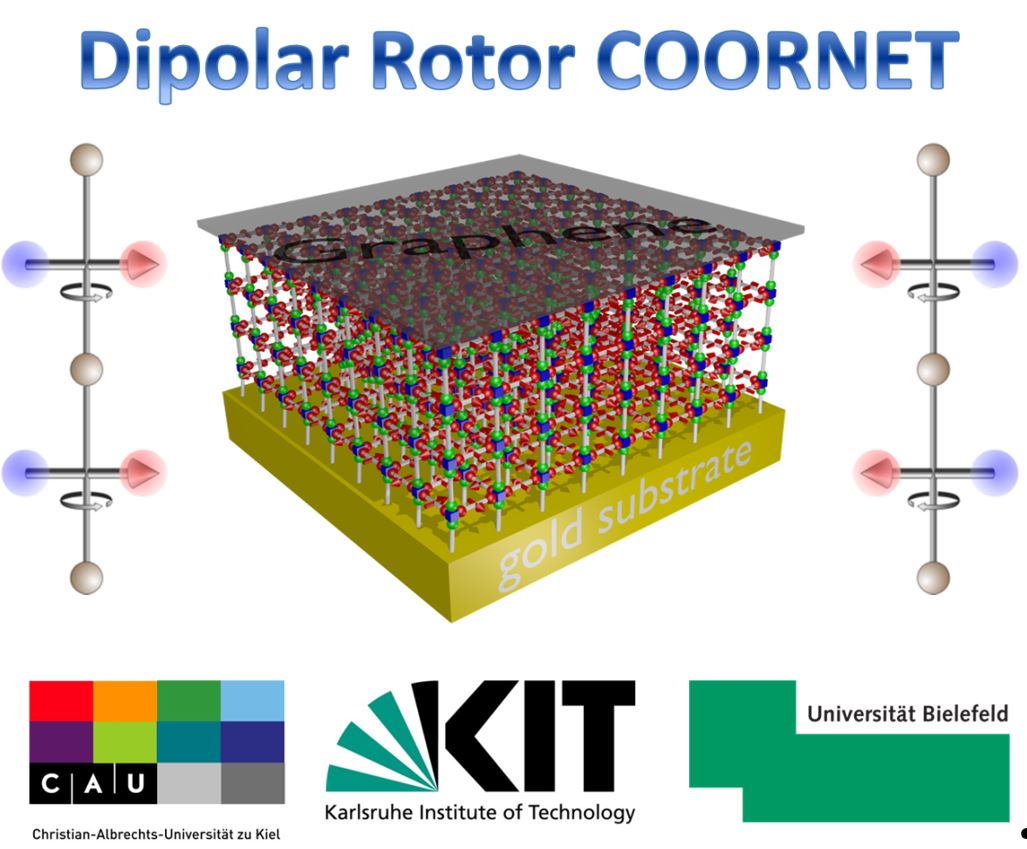| [Translate to en:] Konsortium: | Prof. Dr. Rainer Herges, Kiel Christian-Albrechts-Universität zu Kiel Otto-Diels-Institut für Organische Chemie |
| Dr. Ian Howard, Karlsruhe Karlsruher Institut für Technologie Institute for Microstructure Technology | |
| Dr. Xianghui Zhang, Bielefeld Universität Bielefeld Physics of Supramolecular Systems and Surfaces | |
| Projekt: | Dipolar molecular rotors in SURMOFs |
| Zusammenfassung: | Dipolar molecular rotors are molecules that consist of a dipolar rod-like unit that can rotate about the fixed axis of the stator component. Several approaches have been developed to mount such dipolar molecular rotors on surfaces, or in crystal lattices in such a way that sufficient free volume is available for free rotation. The dipole moment of the rotor should make it possible to manipulate its position with an external electric field. Furthermore, if the interaction between the dipoles is sufficiently large (i.e. the distance between the dipoles is sufficiently small and controlled) spontaneous ordering of the rotors is expected. Many attempts notwithstanding, both phenomena have not been observed or reported so far, with the exception of single molecular rotors on metal surfaces that have been aligned in the huge electric field generated by STM tips. This project will use surface-anchored metal-organic frameworks (SURMOFs) as the molecular scaffold that provides order to arrays of dipolar molecular rotors. As the stator can be integrated into SURMOF, serving as the organic linker between metal centers, the SURMOFS provide a modular architecture to arrange dipolar rotors and to control the intermolecular distances on the dimensions essential to tailor mutual dipole-dipole interactions. This design principle has the advantage that the dipoles are not separated by the molecular framework (molecular cages or bulky groups) which were previously used to provide the free volume for rotation. By supporting denser packing of dipolar rotors, dipolar rotor SURMOFs should be able to allow intermolecular dipole-dipole interactions large enough to induce collective behavior in the rotors. Under correct conditions bi- or multistability of different ordering patterns of the dipoles may be achieved. In this project we will synthesize the dipolar rotor ligands, fabricate the dipolar rotor SURMOFS, and study the physics of the crystalline arrays of interacting dipolar rotors. We will pursue eliciting macroscopic responses of the dipolar rotor system to external stimuli, focusing on achieving fast modulation of optical properties in response to electrical input. |
| Publikationen: | F. L. Otte, S. Lemke, C. Schuett, N. R. Krekiehn, U. Jung, O. M. Magnussen, R. Herges "Ordered monolayers of free- standing porphyrins on gold, attachment of chromophores to metal" J. Am. Chem. Soc. 2014, 136, 11248-11251 DOI: 10.1021/ja505563e |
| A. Modrow, D. Zargarani, R. Herges, N. Stock "The first porous MOF with photoswitchable linker molecules" Dalton Trans. 2011, 40, 4217-4222 DOI: 10.1039/C0DT01629B | |
| P. Penner, X. H. Zhang, E. Marschewski, F. Behler, P. Angelova, A. Beyer, J. Christoffers, A. Gölzhäuser "Charge Transport through Carbon Nanomembranes" Journal of Physical Chemistry C 2014, 118, 21687-21694 DOI: 10.1021/jp506689n | |
| X. H. Zhang, C. Neumann, P. Angelova, A. Beyer, A. Gölzhäuser "Tailoring the Mechanics of Ultrathin Carbon Nanomembranes by Molecular Design" Langmuir 2014, 30, 8221–8227 DOI: 10.1021/la501961d | |
| J. Liu, W. Zhou, J. Liu, I. A. Howard, G. Kilibarda, S. Schlabach, D. Coupry, M. Addicoat, S. Yoneda, Y. Tsutsui, T. Sakurai, S. Seki, Z. Wang, P. Lindemann, E. Redel, T. Heine, C. Wöll "Photoinduced Charge-Carrier Generation in Epitaxial MOF Thin Films: High Efficiency as a Result of an Indirect Electronic Band Gap?" Angew. Chem. Int. Ed. 2015, 54, 7441–7445 DOI: 10.1002/anie.201501862 | |
| M. Meister, B. Baumeier, N. Pschirer, R. Sens, I. Bruder, F. Laquai, D. Andrienko, I. A. Howard "M. Meister, B. Baumeier, N. Pschirer, R. Sens, I. Bruder, F. Laquai, D. Andrienko, I. A. Howard" J. Phys. Chem. C 2013, 117, 9171-9177 DOI: 10.1021/jp403268c | |
| X. Zhang, E. Marschewski, P. Penner, Th. Weimann, P. Hinze, A. Beyer, A. Gölzhäuser "Large-Area All-Carbon Nanocapacitors from Graphene and Carbon Nanomembranes" ACS Nano 2018, 12, 10301–10309 DOI: 10.1021/acsnano.8b05490 | |
| X. Zhang, M. Mainka, F. Paneff, H. Hachmeister, A. Beyer, A. Gölzhäuser, Th. Huser "Surface-Enhanced Raman Spectroscopy of Carbon Nanomembranes from Aromatic Self-Assembled Monolayers" Langmuir 2018, 34, 12692–2698 DOI: 10.1021/acs.langmuir.7b03956 | |
| X. Zhang, E. Marschewski, P. Penner, A. Beyer, A. Gölzhäuser "Investigation of electronic transport through ultrathin carbon nanomembrane junctions by conductive probe atomic force microscopy and eutectic Ga–In top contacts" Journal of Applied Physics 2017, 122, 055103 DOI: 10.1063/1.4995533 | |
| M. Adams, N. Baroni, M. Oldenburg, F. Kraffert, J. Behrends, R. W. MacQueen, R. Haldar, D. Busko, A. Turshatov, G. Emandi, M. O. Senge, C. Wöll, K. Lips, B. S. Richards, I. A. Howard "Reaction of porphyrin-based surface-anchored metal–organic frameworks caused by prolonged illumination" Phys. Chem. Chem. Phys. 2018, 20, 29142-29151 DOI: 10.1039/C8CP05254A | |
| M. Adams, M. Kozlowska, N. Baroni, M. Oldenburg, R. Ma, D. Busko, A. Turshatov, G. Emandi, M. O. Senge, R. Haldar, C. Wöll, G. U. Nienhaus, B. S. Richards, I. A. Howard "Highly Efficient One-Dimensional Triplet Exciton Transport in a Palladium–Porphyrin-Based Surface-Anchored Metal–Organic Framework" ACS Appl. Mater. Interfaces 2019, 11, 17, 15688-15697 DOI: 10.1021/acsami.9b03079 | |
| R. Haldar, A. Mazel, M. Krstić, Q. Zhang, M. Jakoby, I. A. Howard, B. S. Richards, N. Jung, D. Jacquemin, S. Diring, W. Wenzel, F. Odobel, C. Wöll "A de novo strategy for predictive crystal engineering to tune excitonic coupling" Nat. Commun. 2019, 10, 2048 DOI: 10.1038/s41467-019-10011-8 |
Skip to content
Menu
- de
- en
Google Custom Search
Wir verwenden Google für unsere Suche. Mit Klick auf „Suche aktivieren“ aktivieren Sie das Suchfeld und akzeptieren die Nutzungsbedingungen.
